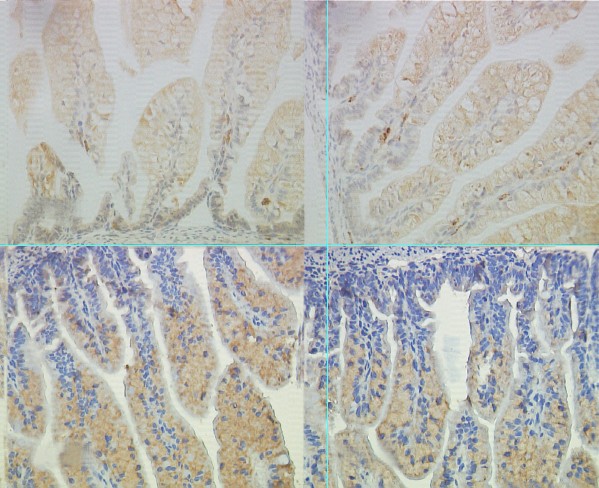目的:研究坏死性小肠结肠炎(NEC)新生大鼠肠道组织中Toll样受体4(TLR4)和caspase-3的表达情况,探讨谷氨酰胺(Gln)对NEC肠道保护作用的可能机制。方法:60只早产新生大鼠随机分为模型组、Gln组和对照组(n=20)。代乳品人工喂养+缺氧+冷刺激建立NEC模型,Gln组采用代乳品+Gln(0.3 g/kg)人工喂养,同时给予缺氧冷刺激,对照组未进行任何干预,第3天处死后取出肠道,苏木素-伊红染色后对回肠进行病理评分,免疫组织化学检测空肠、回肠及结肠caspase-3、TLR-4蛋白的表达,实时荧光定量PCR检测空肠、回肠及结肠TLR-4 mRNA的表达。结果:与对照组相比,模型组的病理评分、caspase-3、TLR-4蛋白和TLR-4 mRNA的表达均增加(P<0.01);与模型组相比,Gln组的各项指标均有所下降(P<0.05)。结论:TLR-4可能参与了NEC的发病机制,降低TLR-4的表达,抑制肠黏膜细胞的凋亡可能是Gln保护NEC新生大鼠肠道的机制之一。
Abstract
OBJECTIVE: To study the expression of Toll-like receptor 4 (TLR-4) and caspase-3 in the intestine of neonatal rats with necrotizing enterocolitis (NEC), and explore the protective effects and possible regulatory mechanisms of glutamine (Gln) in NEC. METHODS: Sixty premature rats were randomly divided into three groups (n=20 each): control, NEC model and Gln intervention group. NEC model was prepared by formula feeding, hypoxia and cold stress. The Gln intervention group was also subjected to hypoxia and cold stress but was fed with formula containing Gln (0.3 g/kg). Two days later, the rats were sacrificed and the intestine tissues were obtained. The histological changes of ileal tissues were observed by hemetoxylin and eosin staining. The expression of caspase-3 and TLR-4 protein in the jejunum, ileum and colon were detected by inmunohistochemistry. The expression of TLR-4 mRNA in the jejunum, ileum and colon were detected by RT-PCR. RESULTS: Compared with the control group, the histological score of ileal tissues, and the expression of caspase-3, TLR-4 protein and TLR-4 mRNA in the NEC model group increased significantly (P<0.01). Gln intervention decreased significantly the histological score of ileal tissues, and the expression of caspase-3, TLR-4 protein and TLR-4 mRNA compared with the NEC model group (P<0.05). CONCLUSIONS: TLR-4 might be involved in the pathogenesis of NEC. Gln may provide protective effects on intestine possibly through reducing the TLR-4 expression and then decreasing the apoptosis of intestinal epithelial cells.
关键词
坏死性小肠结肠炎 /
谷氨酰胺 /
Toll样受体4 /
凋亡 /
新生大鼠
Key words
Necrotizing enterocolitis /
Glutamine /
Toll-like receptor 4 /
Apoptosis /
Neonatal rats
{{custom_sec.title}}
{{custom_sec.title}}
{{custom_sec.content}}
参考文献
[1]鄢小建,姚咏明,董宁,于燕,陆家齐,盛志勇.脓毒症大鼠多脏器Toll样受体4基因表达的改变及意义[J].中华肝胆外科杂志,2005,11(1): 31-34.
[2]张金萍,陈超,杨毅.Toll样受体2和4在新生儿感染时的变化及其临床意义[J].中华儿科杂志,2007,45(2):130-133.
[3]Auestad N, Korsak RA, Bergstrom JD, Edmond J. Milk-substitutes comparable to rat's milk, their preparation, composition and impact on development and metabolism in the artificially reared rat[J]. Br J Nutr, 1989, 61(3):495-518.
[4]Le Mandat Schultz A, Bonnard A, Barreau F, Aigrain Y, Pierre-Louis C, Berrebi D, et al. Expression of TLR-2, TLR-4, NOD2 and pNF-kappaB in a neonatal rat model of necrotizing enterocolitis[J]. PLoS One, 2007, 2(10):e1102.
[5]Medzhitov R, Janeway C Jr. The Toll receptor family and microbial recognition[J]. Trends Microbiol, 2000, 8(10): 452-456.
[6]Beutler B. Inferences, questions and possibilities in Toll-like receptor signaling[J]. Nature, 2004, 430(6996): 257-263.
[7]Medzhitov R, Preston-Hurlburt P, Janeway CA Jr. A human homologue of the Drosophila Toll protein signals activation of adaptive immunity[J]. Nature, 1997, 388(6640): 394-397.
[8]Abreu MT, Vora P, Faure E, Thomas LS, Arnold ET, Arditi M. Decreased expression of Toll-like receptor-4 and MD-2 correlates with intestinal epithelial cell protection against dysregulated proinflammatory gene expression in response to bacterial lipopolysaccharide[J]. J Immunol, 2001, 167(3): 1609-1616.
[9]Jilling T, Simon D, Lu J, Meng FJ, Li D, Schy R, et al. The roles of bacteria and TLR4 in rat and murine models of necrotizing enterocolitis[J]. J Immunol, 2006, 177(5):3273-3282.
[10]Houdijk AP, Rijnsburger ER, Jansen J, Wesdorp RI, Weiss JK, McCamish MA, et al. Randomised trial of glutamine-enriched enteral nutrition on infectious morbidity in patients with multiple trauma[J]. Lancet, 1998, 352(9130):772-776.
[11]Novak F, Heyland DK, Avenell A, Drover JW, Su X. Glutamine supplementation in serious illness: a systematic review of the evidence[J]. Crit Care Med, 2002, 30(9): 2022-2029.
[12]常晓,王琳琳,连淑君,唐清,陈萍,王华.谷氨酰胺对内毒素血症幼鼠肠屏障的保护作用[J].中国当代儿科杂志,2010,12(10):809-811.
[13]Kessel A, Toubi E, Pavlotzky E, Mogilner J, Coran AG, Lurie M, et al. Treatment with glutamine is associated with down-regulation of Toll-like receptor-4 and myeloid differentiation factor 88 expression and decrease in intestinal mucosal injury caused by lipopolysaccharide endotoxaemia in a rat[J]. Clin Exp Immunol, 2008, 151(2): 341-347.
[14]Larson SD, Li J, Chung DH, Evers BM. Molecular mechanisms contributing to glutamine-mediated intestinal cell survival[J].Am J Physiol Gastrointest Liver Physiol, 2007, 293(6): G1262-G1271.
[15]Ortega-Cava CF, Ishihara S, Rumi MA, Kawashima K, Ishimura N, Kazumori H, et al. Strategic compartmentalization of Toll-like receptor 4 in the mouse gut[J]. J Immunol, 2003, 170(8):3977-3985.
 PDF(1571 KB)
PDF(1571 KB)


 PDF(1571 KB)
PDF(1571 KB)
 PDF(1571 KB)
PDF(1571 KB)
